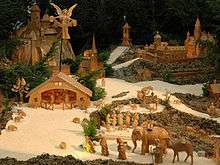Czech Christmas Mass
Czech Christmas Mass (Czech: Česká mše vánoční; Latin: Missa solemnis Festis Nativitatis D. J. Ch. accommodata in linguam bohemicam musikamque redacta – que redacta per Jac. Joa. Ryba) is a classic pastoral mass written by the Czech composer Jakub Jan Ryba in 1796. Because of its opening words, it is also known as Hail, Master! or Hey, Master! (in Czech: Hej, mistře!). Czech Christmas Mass was composed in a frame of traditional Latin mass (with parts Kyrie, Gloria etc.), the story is based on Christian theme of the birth of Jesus of Nazareth. Despite this, the work has a rather pastoral character with emphasis on a Czech description of the nativity in a Czech setting. During the centuries, the composition became the most popular Christmas mass in Czech countries and one of the musical symbols of Czech Christmas.[1][2]
| Česká mše vánoční Czech Christmas Mass | |
|---|---|
| Pastoral mass by Jakub Jan Ryba | |
Title page of a piano reduction | |
| Language | Czech |
| Composed | 1796 |
| Movements | 9 |
| Scoring |
|
Background
Ryba composed his most famous work in 1796, a year after he managed to resolve a dispute over his teaching methods with the priest Kašpar Zachar.[3] He wrote the music to his own Czech libretto; It was his only mass composed to the Czech text.[4] Ryba did not record this mass in his list of compositions created from 1782 to 1798; he mentioned only "seven pastoral masses, one of them in the Czech language".[3] The autograph manuscript was lost; today only the title page is preserved intact. Some parts of the composition were performed separately as pastorales and the text gradually adapted with changes in the Czech language. Though Ryba created more than 1,000 compositions, Czech Christmas Mass remains one of the few works performed regularly to date.
The music of Ryba's mass along with paintings by Josef Lada appear in a 2007 animated film called Česká mše vánoční (Czech Christmas Mass).[5]
Structure
The original key of the composition was A major, however, it was later transposed and arranged in various ways. Today the transposition in G major (a tone lower) is the most commonly used version.[3] The main form of the composition is called ordinarium and consists of six parts. The mass contains characteristic short melodic motifs inspired by the folk music, supported by colorful rhythms.[3] It is often considered a Christmas cantata, based on pastoral motifs. Because of its folk character and simplicity, it has been excluded from the Catholic liturgy. However, it still remains connected with the celebration of traditional Czech Christmas.[3] (According to Czech mezzo-soprano Magdalena Kožená, it was widely performed in local churches on Christmas Eve when she was young.)
The mass consists of nine parts:

- Kyrie (full text) – The opening part begins with a well known verse "Hej, mistře, vstaň bystře!" ("Hey Master, get up quickly!"). A young shepherd wakes his master, they both wonder at various unusual phenomena of nature.
- Gloria (full text) – a hymn to celebrate the birth of Christ
- Graduale (full text) – Shepherds assemble the people from all the regions and lands. The part ends with an appeal: "K Betlému teď půjdeme, Boha slavit budeme." ("We're going to Bethlehem, to celebrate the God.")
- Credo (full text) – In the Czech Christmas Mass, Credo describes the preparations for the pilgrimage to Bethlehem.
- Offertorium (full text) – the gathering over the manger; People offer musical gifts to God and Christ.
- Sanctus (full text) – the shortest part of the composition, an angelic hymn
- Benedictus (full text) – This part with solo soprano in the central role is dedicated to the celebration of the newborn Redeemer.
- Agnus (full text) – parting with Christ, plea for protection of all people
- Communio (full text) – The final part ends with monumental choral hymn celebrating the Holy Trinity.
The original instrumentation of the work was 4 soli, choir, organ, flute, 2 clarinets, 2 horns, clarion (klarina; trumpet), 2 violins, viola, violon-double bass and timpani.
Published scores
- Ryba, Jakub Jan: Česká mše vánoční (Böhmische Hirtenmesse, Czech Christmas Mass) – piano reduction. Prague, Editio Bärenreiter, 2004. M-2601-0325-2.
Recordings
- Jakub Jan Ryba: Czech Christmas Mass; 3 Pastorellas – Magdalena Kožená, Robert Hugo, Capella Regia Musicalis; Deutsche Grammophon Archiv 4778365 (2009).[6]
- Jakub Jan Ryba: Czech Christmas Mass (Česká mše vánoční) – Jaroslava Vymazalová, Marie Mrázová, Beno Blachut, Zdeněk Kroupa, Václav Smetáček conducting the Prague Symphony Orchestra, Josef Veselka and the Czech Philharmonic Chorus; Supraphon SU 3649 (1966).[7]
References
- "Jakub Jan Ryba: Czech Christmas Mass". Prague State Opera. Retrieved 20 December 2009.
- Horáková, Pavla (22 December 2004). "Mass by Jakub Jan Ryba remains symbol of Czech Christmas". Radio Prague. Retrieved 14 December 2009.
- Hoyerová, Ivana. "Rybova Česká mše vánoční" (in Czech). Společnost Jakuba Jana Ryby. Archived from the original on 23 January 2009. Retrieved 20 December 2009.
- "Ryba,J.J. – Česká mše vánoční". Bontonland. Archived from the original on April 14, 2009. Retrieved 19 December 2009. ("V jeho skladatelském odkazu nalezneme řadu mší na latinský text, ale jen jednu na text český.") (in Czech)
- "Česká mše vánoční" (in Czech). Czech Television. Retrieved 19 December 2009.
- "Jakub Jan Ryba: Czech Christmas Mass, Pastorellas". Deutsche Grammophon. Archived from the original on 14 March 2012. Retrieved 20 December 2009.
- "Ryba, J.J. Česká mše vánoční". Supraphon. Retrieved 20 December 2009.